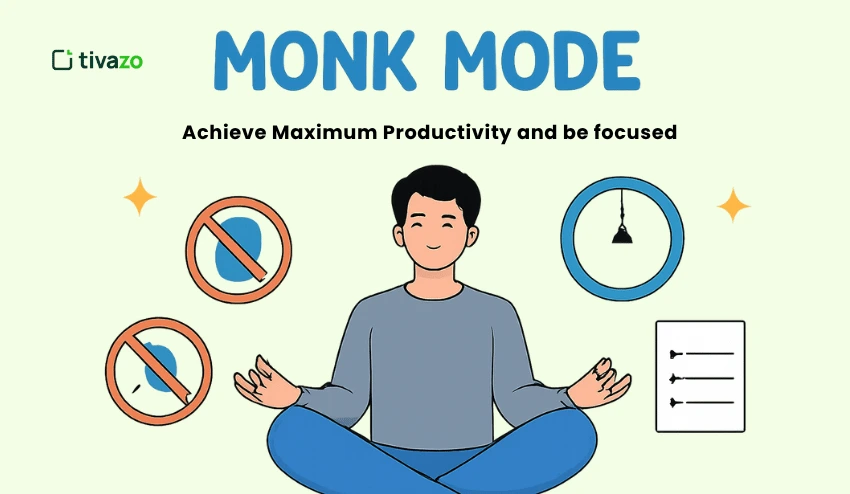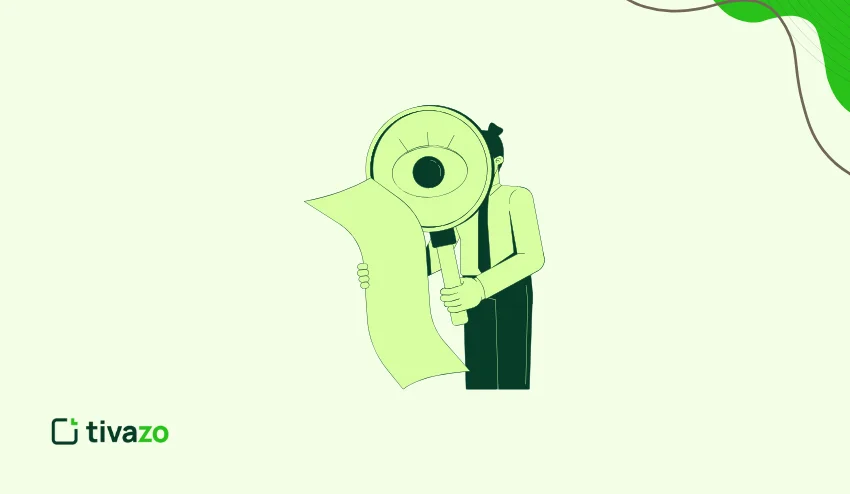In this modern age, it’s increasingly difficult to remain focused and productive. On any given day, we can easily feel like we are running behind and spending the majority of time dealing with distractions, interruptions, notifications, or competing priorities. Wouldn’t it be great if we could turn off distractions and get into a state of deep focus? That is where Monk Mode comes in – a technique that allows you to forget distractions and go all-in on your tasks. In this state, you’ll be focused enough ahead to start showing up at an even higher level than before.
Monk Mode is not about working longer hours; rather, it is about focusing on what matters to you. By dedicating yourself to deep work, reducing distractions, increasing thoughtful clarity, and creating breathing room for uninterrupted productive time, we can do almost anything. In this article, we’ll cover how to implement Monk Mode in your life while improving your ability to resist distractions and position yourself for success. Preparing to meet a more focused and efficient version of yourself.
Key Highlights:
- What Is Monk Mode
- Core Foundations of Mastering Monk Mode
- Ways to Boost Productivity with Monk Mode
- Monk Mode Daily Routine for Peak Productivity
- Pros and Cons of Monk Mode
- Monk Mode vs Pomodoro
What Is Monk Mode? A Deep Dive into the Concept
Monk Mode is an intense focus where you cut out all distractions, both digital and physical, in order to focus fully on one particular task. It is about creating a distraction-free environment in which you can do deep work and work smart, not hard. Monk Mode is properly utilized to allow you to achieve the highest level of productivity and mental clarity possible.
Monk Mode is fundamentally there to help you create focus and cut out noise so that you can concentrate on the things that really matter. It is not just about putting in more hours; it’s about being intentional with your time and energy so that every minute of your day contributes to your goals and your progress.
The 4 Core Foundations of Mastering Monk Mode
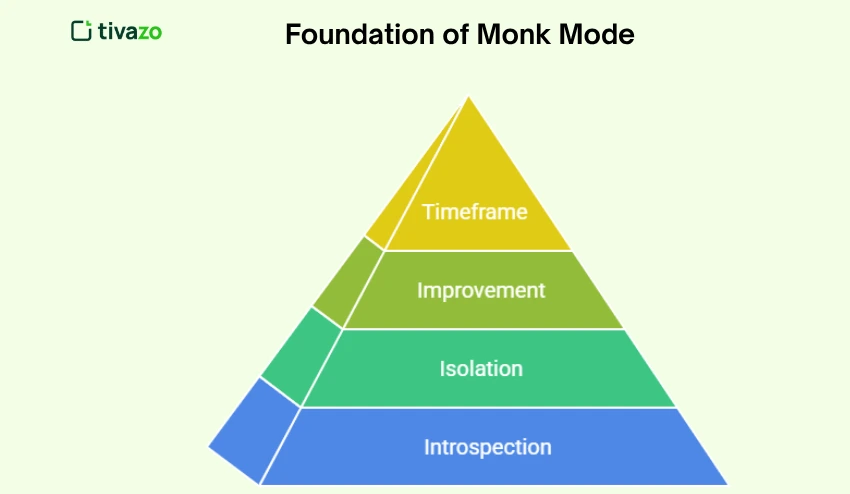
1. Introspection: Deep Dive into Your Habits and Mindset
What does it mean:
Monk Mode begins with a self-assessment. not just about working more, but figuring out why you leave certain tasks undone, or why you get distracted in general. Follow this introspection process to maximize your self-assessment:
- Identify distractions: Identify what draws your attention away.
- Understand your peak times: Find when you’re most energetic to work.
- Pinpoint procrastination triggers: Identify the tasks you avoid altogether
2. Isolation: Create Your Ultimate Focus Zone
What does it mean:
Monk Mode requires you to eliminate distractions, which means external and internal distractions, so you need to make a space for deep work to happen:
- Go on a digital detox: Block social media and notifications.
- Create a focused space: Eliminate noise, clutter, and interruptions.
- Set clear boundaries: Identify how long you need to be uninterrupted and inform others.
3. Improvement: Build Better Work Habits Every Day
What does it mean:
Monk Mode is working smarter and better. After you create a distraction-free way, now focus on iterating your habits:
- Review progress: Regularly assess what’s working and adjust.
- Refine habits: Develop consistent routines that support long-term focus.
- Evolve consistently: Keep iterating ways of thinking based on reflections and reviews.
4. Timeframe: Define Your Focus Period
What does it mean:
It means figuring out how long you want to focus on your work in Monk Mode. By defining a period, you keep the motivation high, distractions low, and a specific start and end date.
Here’s how to approach it:
- Set a start and end date: You can plan a period as long as a week, or as long as a month, or as long as a year.
- Design a focused workspace: Create an environment that supports your goal and eliminates distractions.
- Commit fully: Embrace your timeframe completely, knowing when it begins and ends keeps you on track and energized.
5 Ways to Boost Productivity with Monk Mode
Monk Mode is not only about blocking distractions, but it is about creating a focused environment where focused work can become a habit. Following these strategies, you can suddenly find your productivity through the roof using far less time. Here’s how:
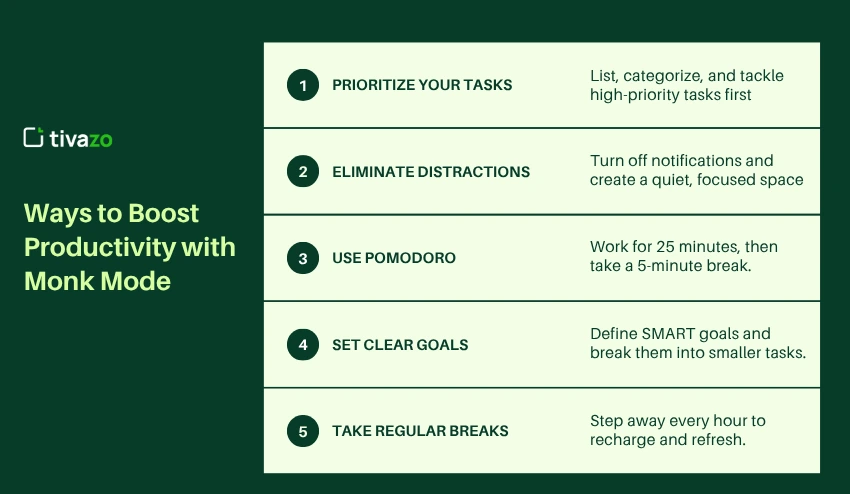
1. Prioritize Your Tasks
When you enter Monk Mode, you want to put your focus on what matters most. A lot of time is wasted on tasks that do not make a real contribution to your goals. Prioritization is important to ensure that you are optimized during your timeframe.
How to do it:
- List your tasks: List all the tasks you need to complete.
- Categorize by importance: The Eisenhower Matrix (Urgent vs. Important) will help you identify the items you want to work on that will move the needle the most.
- Start with high-priority tasks: Do the most crucial items first and leave less important tasks for later. This keeps you on track and prevents being overwhelmed.
2. Eliminate Distractions
Distractions are the greatest killers of productivity. Monk Mode requires a full detachment from anything that could cause you to lose focus. Whether that be notifications on your phone, background noise, or any other distractions, this pillar is about eliminating them.
How to do it:
- Turn off notifications: Disable your phone notifications and email alerts during Monk Mode hours.
- Use productivity apps: Use focus Apps like Freedom, Cold Turkey, or Focus@Will that can block distracting websites and help you stay focused.
- Physical environment matters: Clear your desk, use headphones if necessary, and find a quiet place to boost your productivity and focus.
3. Use Pomodoro within Monk Mode
The Pomodoro Technique is a valuable way to keep focus and productivity at a high level throughout the day. The rhythm of working and resting allows the mind space to remain sharp and focused.
How to do it:
- Set a timer: For 25 minutes of intense work. This is your Pomodoro.
- Take a 5-minute break: Walk away, stretch, or walk around.
- Repeat for 3-4 cycles: After finishing every 4 Pomodoros, take a longer break (30-45 minutes).
4. Set Clear Goals
If you don’t set clear goals, Monk Mode can be aimless. You will want clear goals for each day to make sure you get optimal focus use.
How to do it:
- Define measurable goals: Make them SMART (Specific, Measurable, Attainable, Relevant, and Time-bound). E.g., by the end of the day, “Write 1,000 words” or “Complete 3 project tasks”
- Break goals into smaller tasks: Take large goals and break them down into smaller pieces of action. This will help you stay engaged so that you don’t stall out.
- Visualize success: Take a moment to visualize yourself completing the end goal. This will help you stay motivated and engaged.
5. Take Regular Breaks
It’s always important to take breaks, even during your work sessions, while intensely focusing. Working for too long without breaks will only lead to burnout and diminished mental performance. Monk Mode isn’t simply about working; it’s about working sustainably.
How to do it:
- Take short breaks every hour: After every 50–60 minutes of deep work, you should step away from your work area for 5–10 minutes.
- Get moving: Get up, stretch, walk, or grab a healthy snack. You have just supplied your brain and body with some new energy.
- Use breaks wisely: Do things that promote mental recovery during your breaks. Do not check email or social media, which are prone to unwanted distractions.
Creating Your Monk Mode Daily Routine for Peak Productivity
One of the best ways to take advantage of Monk Mode is to develop a daily routine based on your ideal aims. Here is an example daily routine to help you discover an ultimate Monk Mode productivity advantage:
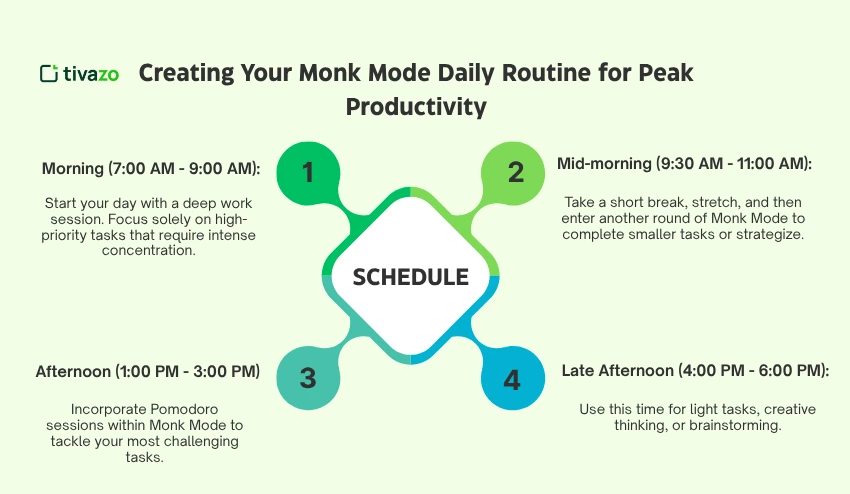
- Morning (7:00 AM – 9:00 AM):
Start a deep work block. A deep work block refers only to the most important high-priority task that requires full concentration. - Mid-morning (9:30 AM – 11:00 AM):
Take a brief break, stretch, and return to another round of Monk Mode to clear up smaller tasks or to plan. - Afternoon (1:00 PM – 3:00 PM):
While in Monk Mode, take some Pomodoros to do the hardest tasks. - Late Afternoon (4:00 PM – 6:00 PM):
At this point in the day, focus on any light tasks, creative thinking, brainstorming, etc.
Structuring your day as monk mode can ensure that every hour is correctly focused and give the most productive outcome possible.
How to Eliminate Distractions and Stay Focused in Monk Mode
Distractions are the biggest threat when you enter Monk Mode, and here is how you remove them:
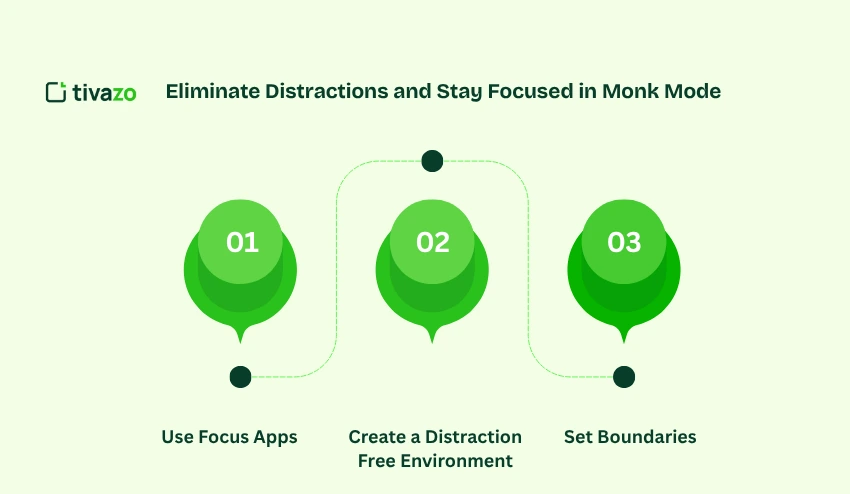
1. Use Focus Apps
Digital distractions typically annoyingly infiltrate your focus when you’re in Monk Mode and commit to working on your important goals. Focus apps, such as Forest, reward you for staying off your phone. Focus@Will provides music that is better for focusing. Cold Turkey or Freedom allows you to block distracting websites for a specific amount of time, so you can work fully concentrated.
2. Create a Distraction-Free Environment
It can be pretty difficult to concentrate in a busy environment or with a cluttered and unorganized desk. Cleaning up your desk and workspace is an important first step to maximizing productivity. Having clutter can steal your attention away, even if it’s subtle. Phone notifications can steal focus. Consider muting apps and emails and turning off notifications. Do your family and or roommates know that you are working in Monk Mode and need time without interruption? Let them know you are busy and need time without conversation or distractions.
3. Set Boundaries
If you work from home or in a shared environment, creating boundaries can help you focus. Make sure your family or roommates know that you are in Monk Mode and not available for conversation. If you can, use the same home, office, or area to work for the deep work without distractions. Noise-canceling headphones can help you minimize distractions, but find the quietest spot you can.
Pros and Cons of Monk Mode
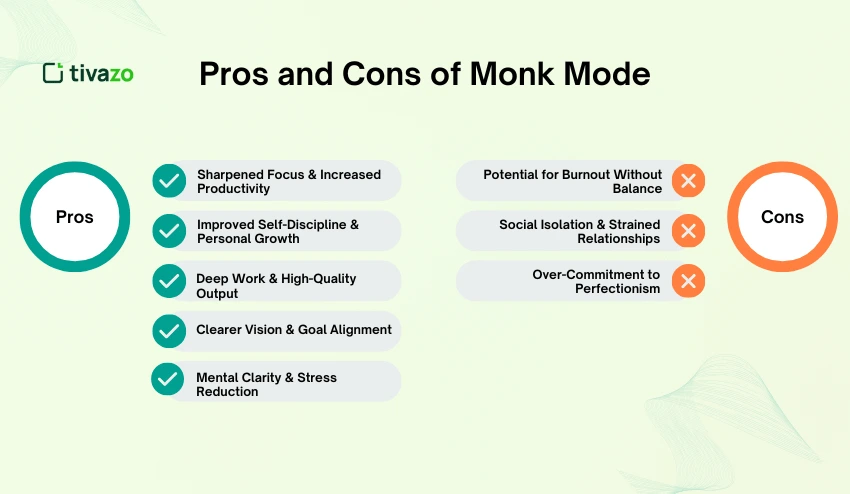
Pros of Monk Mode
Here are the key pros of Monk Mode
1. Sharpened Focus & Increased Productivity
By eliminating distractions, Monk Mode allows for smaller, uninterrupted work blocks to help you go deeper into tasks and be more productive. Ultimately allowing you to complete more in less time and of even higher quality.
2. Improved Self-Discipline & Personal Growth
Using a general framework or structure to direct daily behaviour promotes self-discipline. In doing so, you are developing habits or routines over time that will contribute to your overall growth, development, and success.
3. Deep Work & High-Quality Output
By reducing distractions, Monk Mode creates a deep work experience, where you have uninterrupted focus. Creates space for you to perform high-quality output on what matters without distractions.
4. Clearer Vision & Goal Alignment
Monk mode helps you define clearer goals and then improve actions associated with the goals. In this way, you can focus your attention on actions that get you closer to your bigger vision.
5. Mental Clarity & Stress Reduction
With distractions removed, you are clearing your mind, which eradicates some mental clutter. You’re working with a clearer mental aim, which gives simply the feeling of calmness in progress sobriety.
Cons of Monk Mode
While Monk Mode is beneficial, there are a few challenges. Here are the cons of Monk Mode
1. Potential for Burnout Without Balance
Staying in a narrow state of concentration for a long time can lead to mental fatigue and physical tiredness. You must give yourself breaks to not burning out or hitting mental fatigue.
2. Social Isolation & Strained Relationships
Placing less emphasis on socializing during Monk Mode can sometimes involve a period of social isolation. If this goes too far, your family and friends may feel neglected, which can affect your relationships.
3. Over-Commitment to Perfectionism
In trying to do deep work, you may become over-committed to making each detail perfect. This can cause you to get hung up on unnecessary details. A foolish focus on lesser elements that can set back progress.
Monk Mode vs Pomodoro: Which Is Better for Deep Work?
| Feature | Monk Mode | Pomodoro |
| Focus Duration | Long, uninterrupted deep work sessions. | Short, focused work intervals (25 minutes). |
| Breaks | Minimal breaks, longer work sessions. | Regular breaks (5 minutes after each interval). |
| Best For | Tasks requiring deep, immersive focus. | Tasks needing sustained focus with rest periods. |
| Mental Fatigue | Risk of burnout without breaks. | Prevents burnout by taking regular breaks. |
Conclusion: Embrace the Monk Mode Mindset for Sustainable Productivity
Adopting the Monk Mode mentality means carving out time for focused work, limiting distractions, and taking on a simpler schedule. By practicing Monk Mode, you will be able to focus your energy on the things that are actually important, spending less time doing things that are actually unimportant. Ultimately, this leads to better work performance, time management, and more clarity of mind.
Practicing Monk Mode can lead to focused motivation and less stress. By eliminating overwhelm and concentrating on the things that matter, you will feel a greater sense of energy and seea tangible difference in both your personal and professional life. Monk Mode is not only about working harder but working smarter and anticipating long-term success.
